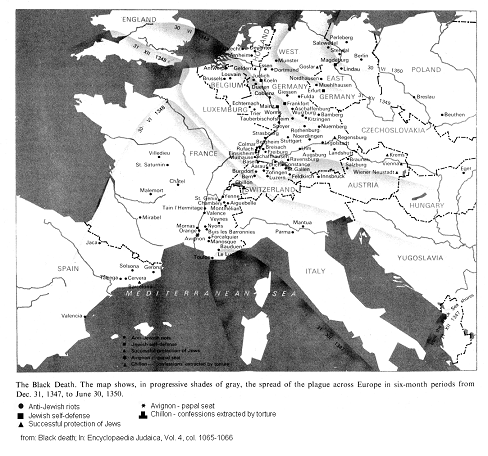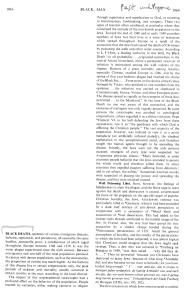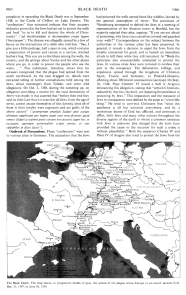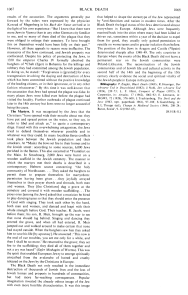[The pasteurella pestis
bacillus - lethal effect according to climate and density
of population]
<BLACK DEATH, epidemic of various contagious diseases,
bubonic, septicemic, and pneumonic, all caused by the same
bacillus,
pasteurella
pestis, a combination of which raged throughout
Europe between 1348 and 1350. It was the worst plague
experienced since the sixth century. Between one-quarter and
one-half of the total population perished.
In centers with denser populations, such as the monasteries,
the proportion of victims was much higher. As the
bacteria of this disease live in certain temperatures only,
the peak periods of sickness and mortality usually occurred
at certain months in the year, according to the local
climate.
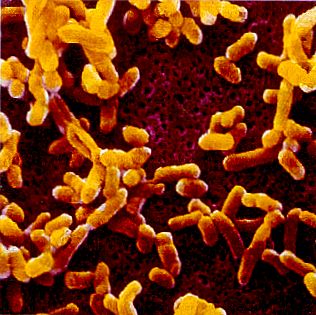
Black plague bacterium Yersinia pestis
(formerly called: pasteurella pestis)
|
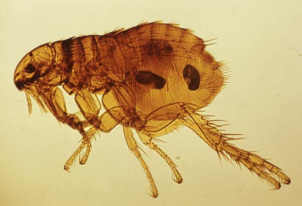
Flea
|
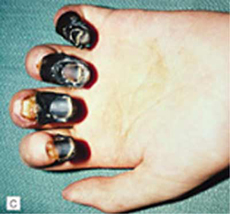
Black plague: Black skin by plague necrosis on the
fingers |
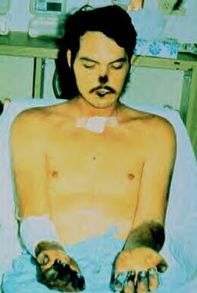
Black plague: Black skin by plague necrosis on the
fingers, on an arm, and in the face on the lips
and on the nose |
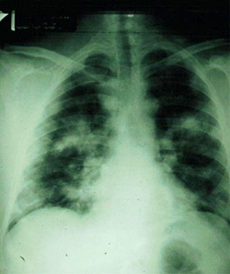
Pneumonic plague, x-ray foto |
[Reactions to the plague -
compensational allegations against the Jews]
The impact of this unprecedented catastrophe had a profound
effect on the behavior of the population. People reacted by
extremes, either seeking recourse to religion (col. 1063)
through repentance and supplication to God, or reverting to
licentiousness, lawbreaking, and savagery. These two types
of reaction often combined in particular where they
concerned the attitude of the non-Jewish population to the
Jews. Toward the end of 1348 and in early 1349 countless
numbers of Jews lost their lives in a wave of massacres
which spread throughout Europe as a result of the accusation
that the Jews had caused the death of Christians by
poisoning the wells and other water sources.
[The spread of the plague
from Asia to Europe: Chinese victims - Tatar victims -
European victims]
According to L. F. Hirst, a leading authority in this field,
the Black Death
"in all probability ... originated somewhere in the central
Asiatic hinterland, where a permanent reservoir of infection
is maintained among the wild rodents of the steppes. Rumors
of a great mortality among Asiatics, especially Chinese,
reached Europe in 1346, and by the spring of that year
bubonic plague had reached the shores of the Black Sea ...
From ports on the shores of the Crimea besieged by Tatars,
who perished in vast numbers from the epidemic ... the
infection was carried on shipboard to Constantinople, Genoa,
Venice, and other European ports. The disease spread as
rapidly as the transport of those days permitted ... to the
Mainland."
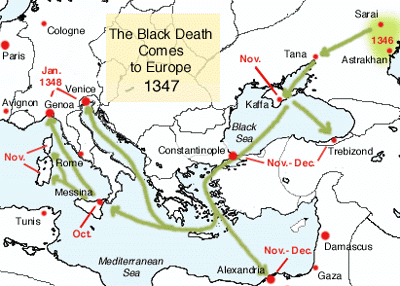
Map 01: Spreading of the Black plague from the
Black Sea |
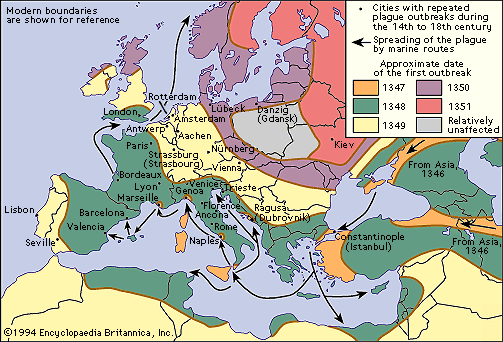
Map 02: Spreading of the Black plague in Europe |
|
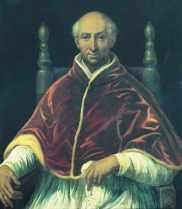
Papsta Clemens VI
|
[The speculations in the
Middle Ages about the cause for the black plague]
At the time of the Black Death no one was aware of this
connection and the existence of contagion was only vaguely
perceived. By some persons the catastrophe was ascribed to
astrological conjunctions; others regarded it as a divine
visitation. Pope *Clement VI, in his bull defending the Jews
from these accusations, saw it as "the pestilence with which
God is afflicting the Christian people". The vast majority
of the population, however, was inclined to view it as a
pestis manufacta (an
artificially induced malady), the simplest explanation to
the unsophisticated mind, and therefore sought the human
agents thought to be spreading the disease.
[The middle age
speculations about the culprits for the plague: Not only
Jews]
Initially, the Jews were not the only persons accused;
strangers of every type were suspected. An Avignonese
physician relates:
"Many hesitated, in some countries people believed that the
Jews intended to poison the whole world and therefore killed
them. In other countries they expelled paupers suffering
from deformity; and in yet others, the nobles."
Sometimes itinerant monks were suspected of placing the
poison and spreading the disease, and they were attacked
instead.
Well Poisoning Libel.
[Anti-Jewish movements
before the plague]
Soon, however, the feelings of helplessness to stem the
plague, and the fierce urge to react against the death and
destruction it caused, concentrated the force of the
populace on the age-old target of popular Christian
hostility , the Jews. Anti-Jewish violence was particularly
rabid in *Germany, where it had been preceded by a dark half
century of anti-Jewish persecution in conjunction with a
succession of *blood libels and accusations of *host
desecration. This had added to the sinister traits already
attributed to the hateful image of the Jews.
In France, also, the way had been paved for this accusation
by a similar charge leveled during the *Pastoureaux
persecutions of 1321.
[The speculation that Jews
would take revenge for persecutions before with black
plague]
Amid the general atmosphere of hostility, and the cruelty of
the persecutions to which the Jews had been subjected, it
was almost logical that Christians could imagine that the
Jews might seek revenge. Thus, a Jew who was tortured in
*Freiburg im Breisgau in 1349, "was then asked ... 'why did
they do it ...?' Then he answered:
'because you Christians have destroyed so many Jews; because
of what king *Armleder did; and also because we too want to
be lords; for you have lorded long enough.' "
(" ... wan umb das, das ir cristan so menigen juden
verdarpten, do kuenig Armleder was, und ouch um das, das wir
ouch herren wolten gewesen sin, wan ir genug lang herren
gewesen sint;" Urkundenbuch der Stadt Freiburg im Breisgau
(1828), nos. 193, 382).
[1348: First torture action
against Jews in
Chillon castle to
confess well poisoning]
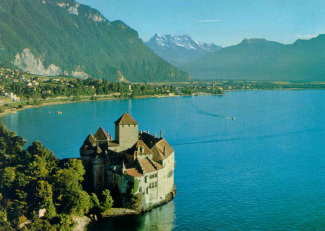
Chillon castle at the Lake of Geneva, place of horror in
1348
The first occasion on which Jews were tortured to confess
(col. 1064)
complicity in spreading the Black Death was in September
1348, in the Castle of Chillon on Lake Geneva. The
"confessions" thus extracted indicate that their accusers
wished to prove that the Jews had set out to poison the
wells and food "so as to kill and destroy the whole of
Christianity" ("ad interficiendam et destruendam totam legem
Christianam"). The disease was allegedly spread by a Jew of
Savoy on the instructions of a rabbi who told him:
"See, I give you a little package, half a span in size,
which contains a preparation of poison on venom in a narrow,
stitched leathern bag. This you are to distribute among the
wells, the cisterns, and the springs about Venice and the
other places where you go, in order to poison the people who
use the water. ..."
This indictment, therefore, shows that his accusers
recognized that the plague had spread from the south
northward. as the case dragged on, details were extracted
telling of further consultations held among the Jews, about
messengers from Toledo, and other wild allegations.
[3 Oct 1348: The
"confessions" are summed up]
On Oct. 3, 1348, during the summing up, and allegation
providing a motive for the total destruction of Jewry was
made; it was asserted that "before their end they said on
their Law that it is true that all Jews, from the age of
seven, cannot excuse themselves of this (crime), since all
of them in their totality were cognizant and are guilty of
the above actions"
("asseruerunt praefati Judaei ante eorum ultimum supplicium
per legem suam esse vera dicentes quod omnes Judaei a septem
annis circum non possint super hoc se excusare, quoniam
universaliter sciant omnes, et sint culpabiles in dicto
facto").
Outbreak of Persecutions.
[The mob believes the
"juridical confessions" of well poisoning -
defamation, killings, expulsions]
These "confessions" were sent to various cities in
Germany. The accusation that the Jews (col. 1065)
had poisoned the wells spread there like wildfire,
fanned by the general atmosphere of terror. The
patricians of *Strasbourg attempted to defend the Jews
at a meeting of representatives of the Alsatian towns at
Benfeld, but the majority rejected their plea, arguing:
"If you are not afraid of poisoning, why have you
yourselves covered and guarded your wells?"
Correspondence on the subject between the authorities in
the various cities has been preserved. In general, it
reveals a decision to expel the Jews from the locality
concerned for good, and to launch an immediate attack to
kill them while they still remained. At *Basle the
patricians also unsuccessfully attempted to protect the
Jews.
In various cities Jews were tortured to confess their
part in the conspiracy. The defamation, killings, and
expulsions spread through the kingdoms of Christian
Spain, France, and Germany, to Poland-Lithuania,
affecting about 300 Jewish communities (see map).
 Map
03:
Spreading of the black plague and pogroms
against the Jews in Europe 1348-1350.
Indications: Anti-Jewish riots, Jewish
self-defense, successful protection of the
Jews, Avignon - papal seat, Chillon -
confessions extracted by torture
|
[26 Sep 1348: Pope Clement
describes "certain Christians seduced by devil"]
On Sept. 26, 1348, Pope Clement VI issued a bull in Avignon
denouncing this allegation, stating that "certain
Christians, seduced by that liar, the devil, are imputing
the pestilence to poisoning by Jews." This imputation and
the massacre of Jews in consequence were defined by the pope
as "a horrible thing". He tried to convince Christians that
"since this pesitlence is all but universal everywhere, and
by a mysterious decree of God has afflicted, and continues
to afflict, both Jews and many other nations throughout the
diverse regions of the earth to whom a common existence with
Jews is unknown (the charge) that the Jews have provided the
cause or the occasion for such a crime is without
plausibility."
Both the emperors Charles IV and Peter IV of Aragon also
tried to protect the Jews from the (col. 1066)
results of the accusation.
[Also Jews are dying by the
plague, e.g. in Vienna]
The arguments generally put forward by the rulers were
expressed by the physician Konrad of Megenberg in his
Buch der Natur arrived
at in the light of his own experience:
"But I know that there were more Jews in Vienna than in any
other German city familiar to me, and so many of them died
of the plague that they were obliged to enlarge their
cemetery. To have brought this on themselves would have been
folly on their part."
However, all these appeals to reason were ineffective. The
massacres of the Jews continued, and Jewish property was
confiscated.
|
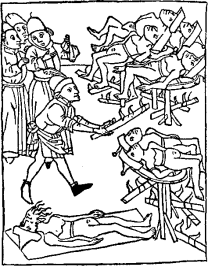
Wheel torture against the Jews in plague times
|
[Emperor Charles IV
legalizes massacres against the Jews, e.g. in Cheb (Eger)]
Despite his policy of protecting the Jews, in 1350 the
emperor Charles IV formally absolved the burghers of *Cheb
(Eger) in Bohemia for the killings and robbery they had
committed among the Jewish population. In doing so, he
stated:
"Forgiveness is (granted) for every transgression involving
the slaying and destruction of Jews which has been committed
without the positive knowledge of the leading citizens, or
in their ignorance, or in any other fashion whatsoever."
By this time it was well-known that the accusation that Jews
had spread the plague was false.
[Massacres against the Jews
even before the plague is coming - further plague
outbreaks without massacres]
In many places Jews were killed even before the plague had
visited the locality. Further outbreaks of plague continued
later in the 14th century but Jews were no longer accused of
being the cause.
The Martyrs.
[The imprinting of the
Jewish spirit by the plague persecution - fights and
massacres - Jewish self destruction]
It was recognized by the Jews that the Christians "have
opened wide their mouths about me: they have put and spread
poison on the water, so they say, in order to libel and
attack us", to quote a contemporary dirge.
Faced with this overwhelming antagonism, the Jews tried to
defend themselves wherever possible and in whatever way they
could. In many localities fierce conflicts took place
between the Jewish population and their attackers.
At *Mainz the Jews set fire to their homes and to the Jewish
streets: according to some sources, 6,000 Jews perished in
the flames. This also occurred at *Frankfort on the Main. In
Strasbourg, 2,000 Jews were burnt on a wooden scaffold in
the Jewish cemetery. The manner in which the martyrs met
their deaths is described in a contemporary Hebrew source
concerning
"the holy community of Nordhausen. ... They asked the
burghers to permit them to prepare themselves for martyrdom:
permission having been given ... they joyfully arrayed
themselves in their prayer shawls and shrouds, both men and
women. They [the Christians] dug a grave at the cemetery and
covered it with wooden scaffolding ... The pious ones [among
the Jews] asked that a musician be hired to play dancing
tunes so that they should enter the presence of God with
singing. They took each other by the hand, both men and
women, and danced and leapt with their whole strength before
God. Their teacher, R. Jacob, went before them; his son, R.
Meir, brought up the rear to see that none should lag
behind. Singing and dancing they entered the grave, and when
all had entered, R. Meir jumped out and walked around to
make certain that none had stayed outside. When the burghers
saw him they asked him to save his life [by apostasy]. He
answered: 'This now is the end of our troubles, you see me
only for a while, and then I shall be no more.' He returned
to the grave; they set fire to the scaffolding; they died
all of them together and not a cry was heard" (
Sefer Minhagim of
Worms).
This was the spirit that enabled European Jewry to emerge
spiritually unscathed from the avalanche of hatred and
cruelty released on the Jews by the Christians in Europe.
[The imprinting of the
"Christian" spirit by the plague: Horrible picture of the
Jew]
The Black Death not only resulted in the immediate
destruction of thousands of Jewish lives and the loss of
Jewish homes and property in hundreds of communities, but
had more far-reaching consequences. Popular imagination
invested the already odious image of the Jew with even more
horrible characteristics. It was this image (col. 1067)
that helped to shape the stereotype of the Jew represented
by *anti-Semitism and racism in modern times.
[Deteriorating Jewish
status after the Black Plague - flight to
Poland-Lithuania]
After the Black Death the legal status of the Jews
deteriorated almost everywhere in Europe. Although Jews were
frequently received back into the cities where many had been
killed or driven out, sometimes within a year of the
decision to expel them for good, they usually only gained
permission to resettle on worse terms and in greater
isolation than before.
The position of the Jews in Aragon and Castile (*Spain)
deteriorated sharply after 1348-49. The only countries in
Europe where the events of the Black Death did not leave
permanent scar on the Jewish communities were
Poland-Lithuania. the
reconstruction of the Jewish communities and of Jewish life
and cultural activity in the second half of the 14th and the
beginning of the 15th century clearly evidence the social
and spiritual vitality of the Jewish people in Europe in the
period.
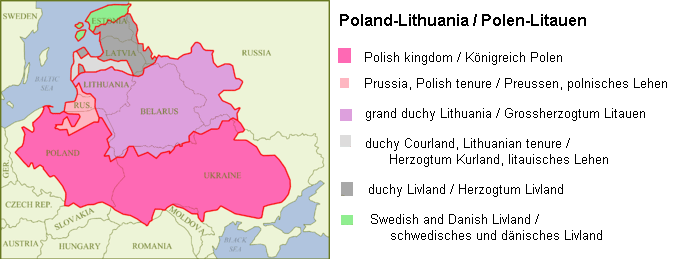
Map 04: Poland-Lithuania, a territory from Baltic
Sea to the Black Sea |
|
[[Later since 1491 when Colombus brought smoking to Europe
there was the belief that the smoke from smoking would
hinder black plague and have a desinfecting effect...]]
[[And Poland-Lithuania is precisely the territory of the
later Jewish "Pale of Settlement"]].
Bibliography
-- P. Ziegler: Black Death (1969)
-- R. Hoeniger: Der schwarze Tod in Deutschland (1882)
-- J. Nohl: Der schwarze Tod (1924), 239-73
-- L. F. Hirst: Conquest of Plague (1953)
-- E. Carpentier, in: Annales, 17 (1962), 1062-92
-- E. Littmann, in: MGWJ, 72 (1928), 576-600
-- J. Trachtenberg: The Devil and the Jews (1943, repr.
paperback 1961), 97-108
-- S. Guerchberg, in: S. L. Thrupp (ed.): Change in Medieval
Society (1964), 208-24
-- Baron, Social, 9-12 (1965-67)
[H.H.B.-S.]> (col. 1068)
Map 03: Spreading of the black plague and pogroms against the Jews in Europe 1348-1350. Indications: Anti-Jewish riots, Jewish self-defense, successful protection of the Jews, Avignon - papal seat, Chillon - confessions extracted by torture












